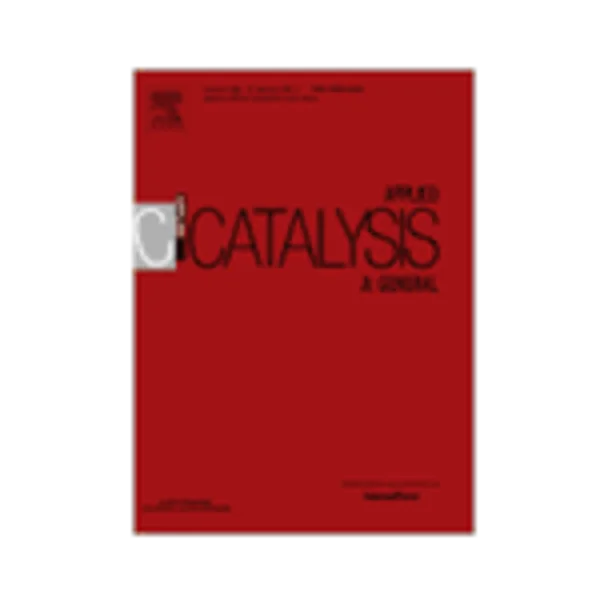-
catalysed ethylbenzene dehydrogenation in co2 or n2—carbon deposits as the active phase
جزئیات بیشتر مقاله- تاریخ ارائه: 1392/07/24
- تاریخ انتشار در تی پی بین: 1392/07/24
- تعداد بازدید: 1045
- تعداد پرسش و پاسخ ها: 0
- شماره تماس دبیرخانه رویداد: -
bare alumina support transforms into an active catalyst for the dehydrogenation of ethylbenzene to styrene in co2 or n2. during the first 15 h time on stream in co2, or the first 10 h time on stream in n2, the alumina shows an increase in ethylbenzene conversion and styrene selectivity from 15% to 60% and from 60% to 92%, respectively, under industrially relevant conditions of 600 °c and 10 vol% ethylbenzene. thereafter, the system slowly deactivates, but remains highly selective. tga analysis shows an increase in coke content. the specific surface area and pore volume show a decrease with time on stream. tem-imaging reveals that the spent catalyst surface is completely covered by several layers of coke. these results combined suggest that the carbon deposits on the alumina are responsible for the increase in activity and selectivity, and also are the cause of deactivation once a monolayer of carbon is deposited on the support surface. similar trends are observed for zirconia support. supported vanadium and chromium oxides on alumina all give similar results, but after a faster activity development. also for these supported catalysts and even carbon samples, deposited coke is the active and selective phase.
مقالات جدیدترین رویدادها
-
استفاده از تحلیل اهمیت-عملکرد در ارائه الگوی مدیریت خلاقیت سازمانی و ارائه راهکار جهت بهبود
-
بررسی تاثیر ارزش وجوه نقد مازاد بر ساختار سرمایه شرکت های پذیرفته شده در بورس اوراق بهادار تهران
-
بررسی تأثیر سطح افشای ریسک بر قرارداد بدهی شرکت های پذیرفته شده در بورس اوراق بهادار تهران
-
بررسی تأثیر رتبه بندی اعتباری مبتنی بر مدل امتیاز بازار نوظهور بر نقد شوندگی سهام با تأکید بر خصوصی سازی شرکت ها
-
تأثیر آمیخته بازاریابی پوشاک ایرانی بر تصویر ذهنی مشتری پوشاک ایرانی (هاکوپیان)
-
ویژگی های شهر اسلامی
-
طراحی سیر کولاتور هم صفحه خود بایاس با استفاده از لایه ی ضخیم فریت استرانسیوم
-
بررسی تحلیل رفتار متقابل گیاه و جریان جهت تبیین مبانی مدل ریاضی خسارت کشاورزی
-
synthesis and antimicrobial action of ag-zeolite a
-
oblique water waves impacting on a thin porous wall with a partial-slipping boundary condition
مقالات جدیدترین ژورنال ها
-
مدیریت و بررسی افسردگی دانش آموزان دختر مقطع متوسطه دوم در دروان کرونا در شهرستان دزفول
-
مدیریت و بررسی خرد سیاسی در اندیشه ی فردوسی در ادب ایران
-
واکاوی و مدیریت توصیفی قلمدان(جاکلیدی)ضریح در موزه آستان قدس رضوی
-
بررسی تاثیر خلاقیت، دانش و انگیزه کارکنان بر پیشنهادات نوآورانه کارکنان ( مورد مطالعه: هتل های 3 و 4 ستاره استان کرمان)
-
بررسی تاثیر کیفیت سیستم های اطلاعاتی بر تصمیم گیری موفق در شرکتهای تولیدی استان اصفهان (مورد مطالعه: مدیران شرکتهای تولیدی استان اصفهان)
-
بررسی نهادهای موثر و ارزیابی حاکمیت شرکتی و جایگاه آن در نظام بانکداری اسلامی و ایران
-
بررسی رابطه بین ادراک های فردی و قصد سرمایه گذاری سهامداران خرد بازار بورس اوراق بهادار مبتنی بر نظریه رفتار برنامه ریزی شده (tpb)
-
پیش بینی احساس تنهایی در مردان سالمند شهر کرمانشاه بر اساس شفقت به خود، معنویت و سبک زندگی اسلامی
-
جایگاه آموزش چند فرهنگی در آموزش مدرسه ای و آموزش عالی
-
adaptive reuse of the industrial building: a case of energy museum in sanatistanbul, turkey




سوال خود را در مورد این مقاله مطرح نمایید :